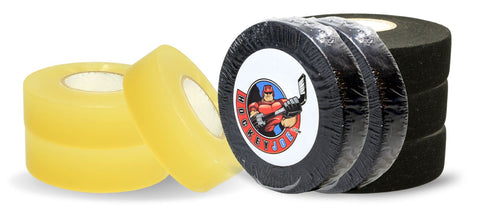Hockey tape is a staple in any hockey player's bag. It's a simple yet versatile material used for various purposes, from providing a better grip on a hockey stick to securing protective equipment in place. While it may seem trivial, having the right tape and understanding its proper application can make a significant difference in a player's performance on the ice. We'll explore the world of hockey tape, its types, uses, and some tips to get the most out of it.
Types of Hockey Tape

-
Cloth Tape: Cloth hockey tape is the most common type of tape used by players. It's made from tightly woven cotton fibers that provide excellent grip and durability. Available in a variety of colors and widths, cloth tape is typically used for wrapping hockey stick blades and handles. Hockey Joe offers cloth tape in the two most sought-after colors, white and black. With a perfect balance of weight, it's neither too heavy nor too light, providing the ideal tape solution.
-
Friction Tape: Friction tape is a type of cloth tape coated with a sticky adhesive on both sides. Its tackiness adds more grip to a hockey stick, but it tends to wear out more quickly than regular cloth tape.
-
Clear (Shin) Tape: Clear hockey tape, also known as shin tape or sock tape, is a stretchy polyurethane material used for securing socks and shin guards. It's strong, durable, and water-resistant, making it an excellent choice for keeping equipment in place during games. Hockey Joe offers the finest quality hockey sock tape available on the market!
Uses of Hockey Tape
-
Stick Blade: Taping the blade of a hockey stick improves puck handling, control, and shot accuracy. It also adds a layer of protection to the blade, extending its lifespan.
-
Stick Handle: Wrapping the handle of a hockey stick with tape provides a better grip and reduces the chances of the stick slipping from a player's hands during play. It also helps to dampen vibrations, providing a more comfortable feel.
-
Shin Guards and Socks: Using clear tape to secure shin guards and socks helps keep protective gear in place, ensuring proper coverage and protection during games.
Tips for Using Hockey Tape
-
Choose the Right Width: Hockey tape comes in various widths, usually 1" or 1.5". When taping a stick blade, it's essential to choose the right width to provide adequate coverage without too much overlap. For the handle, wider tape can offer more cushioning, while thinner tape allows for a more streamlined grip.
-
Replace Tape Regularly: Hockey tape tends to wear down over time, losing its grip and effectiveness. Regularly replacing the tape on your stick and equipment ensures optimal performance.
-
Tape Direction: When taping a stick blade, start at the heel and work your way to the toe. This direction ensures that the tape overlaps in a way that prevents it from peeling off during play.
-
Be Consistent: Find a taping method that works best for you and stick with it. Consistency helps develop muscle memory and improves overall performance on the ice.
Hockey tape may seem like an inconsequential accessory, but it's an essential tool for any hockey player. Understanding its types, uses, and proper application can greatly enhance your game, providing better grip, control, and protection. With this guide in hand, you're now well-equipped to navigate the world of hockey tape and make the most of this simple yet indispensable tool.



